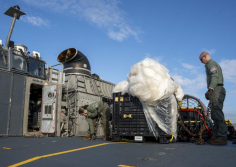After downing China’s alleged high-altitude spy balloon, U.S. moves into recovery — and discovery — phase

The Navy, Marine Corps and FBI are working to recover what the Pentagon is calling “sensitive” Chinese technology from the high-altitude balloon that traversed across the North American continent this week.
Under President Biden’s direction, the balloon was shot down by an F-22 fighter jet at 2:39pm EST Saturday, senior government officials told reporters in a briefing shortly after that “engagement” to wipe out the platform.
Multiple U.S. weapons were mobilized for the operation, but the gigantic balloon was hit by a single AIM-9X missile shot from the jet, approximately six nautical miles off the coast of South Carolina. Although the People’s Republic of China previously released a statement claiming the system was blown off-course in the midst of a weather research mission, the U.S. has maintained that the balloon enables the Chinese to conduct intelligence-gathering and surveillance since it was first acknowledged by the Pentagon on Thursday.
On Wednesday, Biden authorized the U.S. military to take out the balloon as soon as the mission could be performed without posing a threat to people on the ground. That opportunity came Saturday, the officials confirmed. Before that, though, the U.S. government and military “took immediate steps to protect against the balloon’s collection of sensitive information,” they said.
“In addition, shooting the balloon down can enable the U.S. to recover sensitive PRC equipment. I would also note that, while we took all necessary steps to protect against the PRC surveillance balloon’s collection of sensitive information, the surveillance balloon’s overflight of U.S. territory was of intelligence value to us. I can’t go into more detail — but we were able to study and scrutinize the balloon and its equipment which have been valuable,” a senior defense official said during the briefing on Saturday.
The Pentagon has assessed that there is also now another alleged high-altitude Chinese spy balloon transiting across Central and South America at time of publication — and other unmanned aerial systems like it also have been spotted across five continents in the last few years.
“These balloons are all part of a PRC fleet of balloons developed to conduct surveillance operations, which have also violated the sovereignty of other countries. These kinds of activities are often undertaken at the direction of the People’s Liberation Army,” the senior defense official said, later noting “we have notified the PRC about our action, and we are briefing allies and partners.”
A large payload connected to the bottom of the now-downed balloon is anticipated to be the main component that likely hosts much of the platform’s reported intelligence gathering capabilities. During the call, officials were vague about how long they expect for the ongoing, multi-partner recovery mission to take to salvage as much of the balloon’s components as possible for future study.
“The timeline for recovery, at this point, is relatively unknown. We have multiple U.S. Navy vessels and Coast Guard vessels in the region right now establishing a security perimeter and a conducting searches for any debris that may be underwater,” a senior military official said on the call.
Navy divers are prepared to go support the recovery operation, if needed.
“We’ll also have unmanned vessels that can go down to get the structure and lift it back up on the recovery ship. [This is] a collaborative effort — we’ll have the FBI onboard as well under the counter-intelligence authorities to also be categorizing and assessing the platform itself,” the senior military official said.
Once it’s recovered, U.S. researchers will deeply study the system’s components to unravel the technology and puzzle out what was surveilled — particularly over sensitive military nuclear sites.
The Pentagon’s early assessment is that the balloon “was not likely to provide significant added value above other PRC intel capabilities such as satellites in low Earth orbit, for example,” the senior defense official said. But, “we’ll learn more as we pick up the debris,” they added.






